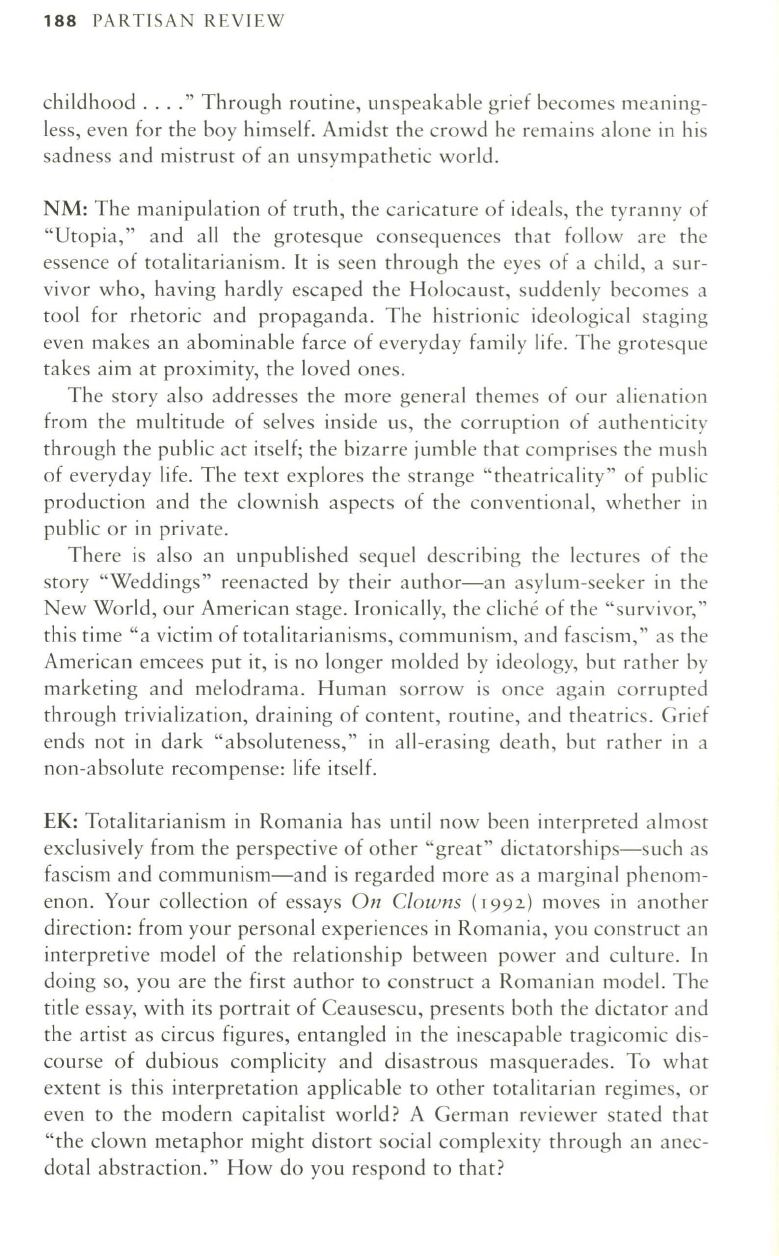
188
PARTISAN REVIEW
childhood .... " Through routine, unspeakable grief becomes meaning–
less, even for the boy himself. Amidst the crowd he remains alone in his
sadness and mistrust of an unsympathetic world.
NM: The manipulation of truth, the caricature of ideals, the tyranny of
"Utopia," and all the grotesque consequences that follow are the
essence of totalitarianism. It is seen through the eyes of a child, a sur–
vivor who, having hardly escaped the Holocaust, suddenly becomes a
tool for rhetoric and propaganda. The histrionic ideological staging
even makes an abominable farce of everyday family life. The grotesque
takes aim at proximity, the loved ones.
The story also addresses the more general themes of our alienation
from the multitude of selves inside us, the corruption of authenticity
through the public act itself; the bizarre jumble that comprises the mush
of everyday life. The text explores the strange "theatricality" of public
production and the clownish aspects of the conventional, whether in
public or in private.
There is also an unpublished sequel describing the lectures of the
story "Weddings" reenacted by their author-an asylum-seeker in the
New World, our American stage. Ironically, the cliche of the "survivor,"
this time "a victim of totalitarianisms, communism, and fascism," as the
American emcees put it, is no longer molded by ideology, but rather by
marketing and melodrama. Human sorrow is once again corrupted
through trivialization, draining of content, routine, and theatrics. Grief
ends not in dark "absoluteness," in all-erasing death, but rather in a
non-absolute recompense: life itself.
EK: Totalitarianism in Romania has until now been interpreted almost
exclusively from the perspective of other "great" dictatorships-such as
fascism and communism-and is regarded more as a marginal phenom–
enon. Your collection of essays
On Clowns
(1992)
moves in another
direction: from your personal experiences in Romania, you construct an
interpretive model of the relationship between power and culture. In
doing so, you are the first author to construct a Romanian model. The
title essay, with its portrait of Ceausescu, presents both the dictator and
the artist as circus figures, entangled in the inescapable tragicomic dis–
course of dubious complicity and disastrous masquerades. To what
extent is this interpretation applicable to other totalitarian regimes, or
even to the modern capitalist world? A German reviewer stated that
"the clown metaphor might distort social complexity through an anec–
dotal abstraction." How do you respond to that?


